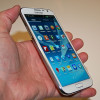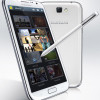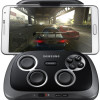Review: Samsung Galaxy Note II for T-Mobile USA
Screen
The screen measures 5.5-inches across the diagonal, compared to the original's 5.3-inches. It actually lost pixels. Where the original had 1280 x 800 pixels, the Note II has 1280 x 720. The aspect ratio has changed to something closer to 16:9. Overall, it's a good display, differences aside. It is as bright and colorful as any Super AMOLED display produced by Samsung. With such a large area to fill, pixels are certainly visible from a close distance (six inches or so), but you have to look hard to see them. It's not as sharp as the GSIII's display, which packs the same number of pixels into a 4.8-inch space. But it's a nice huge canvas on which to interact with your content.
Signal
The Note II did well on T-Mobile's network. It was consistent at connecting to T-Mobile's HSPA+ network and didn't have any problems finding T-Mobile's speedy data network. In fact, the Note II worked perfectly at the crowded launch party Samsung held for the device in New York City, despite the cavernous building filled with hundreds of revelers. I connected phone calls on the first dial, and the Note II didn't drop any calls even though the cell was surely jammed with users. When tested in NJ, it showed strong performance and never dropped to EDGE.
We briefly tested an AT&T variant of the Note II, and based on our limited time with it, saw no network connectivity problems. It was fast on AT&T's HSPA+ network and lightning quick on AT&T's LTE network.
Sound
The Note II is an acceptable voice phone, but falls well short of being good if you don't take care to adjust the phone app's settings. Out of the box, phone calls were inconsistent in quality, with about half demonstrating static, clipping, or cut-outs. Even the calls that were crystal clear were hard to hear thanks to the quiet earpiece. It's OK for quiet environments, but the parents cheering at a local soccer game easily drowned out my conversations on the Note II. The speakerphone is loud enough, but just barely. It has the same quality issues that the earpiece does. Ringtones, alerts, and other noises are audible if you're fairly close by, but I was unable to hear calls when walking around the mall on Saturday afternoon. Using the vibrate alert can help alleviate that issue, though, as it is nice and strong.
However, many of these issues can be resolved if you tweak the phone's settings. For example, you can set the Note II to ring louder when it senses it is in a pocket or purse. It uses the light/proximity sensors and can ring at an elevated volume (above and beyond the max volume setting in normal mode). The tools also allow you to switch noise cancellation on/off. I found it performed better with noise cancellation set to On (default is set to Off). Messing with these settings has a dramatic impact on the quality of phone calls, so be sure to check them out.
The AT&T variant had noticeably better phone call quality without requiring that we dig through the phone app settings. Volume was also much improved over the T-Mobile version.
Battery
The Note II has a 3100mAh battery. Even with the large display and constant use, the Note II easily lasted a day and a half on a single charge. I pushed it to the max over the weekend on Friday and Saturday and still had plenty of power left come Sunday morning. The battery is simply huge, and it provides plenty of power for the Note II. One thing worth noting: the Note II takes a long time to charge. It takes longer than devices with, say, 2000 - 2200mAh batteries. It requires a solid four or five hours to go from 10% to 100% charge. If you charge it every night, you'll have plenty of power to get you through your day.


 Hands-On: Samsung Galaxy Note II
Hands-On: Samsung Galaxy Note II
 Samsung Reveals Galaxy Note 2, Plans U.S. Version
Samsung Reveals Galaxy Note 2, Plans U.S. Version
 Samsung Debuts GamePad for Android Phones
Samsung Debuts GamePad for Android Phones
 Facebook Home and Updated Messenger Hit Android
Facebook Home and Updated Messenger Hit Android
 Samsung Galaxy Note II (GSM)
Samsung Galaxy Note II (GSM)



